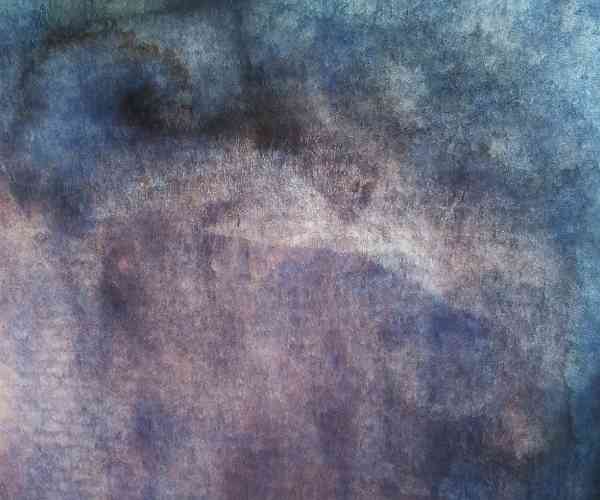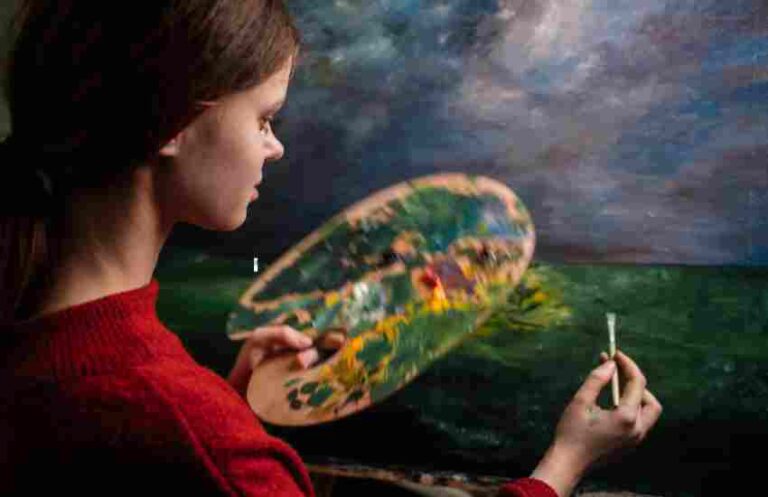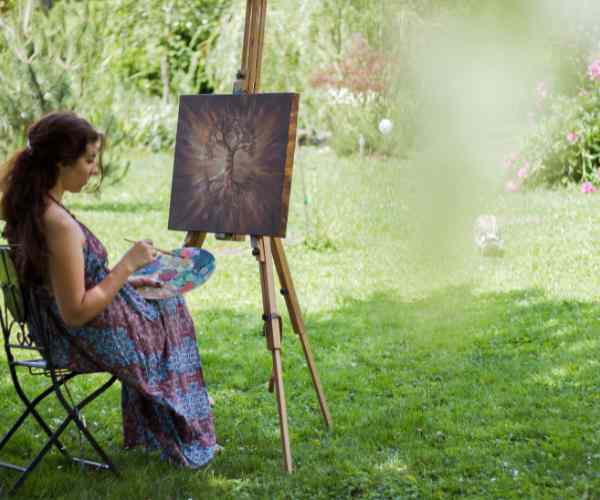Moving from designing to painting is something that should be easy, so one needs to create sketches that come easy, no one hones a pen, Yes we agree this whole idea is enough to get one appreciation and for most artists putting forward such a contemporary idea is a big task as this requires a lot of skill and practice but worry not, we have your back.
I know how easy it is to imagine something but what would really get me excited is how that idea would look in reality which brings us to our next point that word becomes different things in different scenarios, an idea is an idea but in order to bring it forth I need an area which has literally no cramping.
So, allow me to explain what I am trying to say in short this tutorial will walk you through the simple yet complex process of turning your drawings into paintings. Towards the end of this tutorial you will be in a position to move a step further into becoming a better artist. So let’s get started!
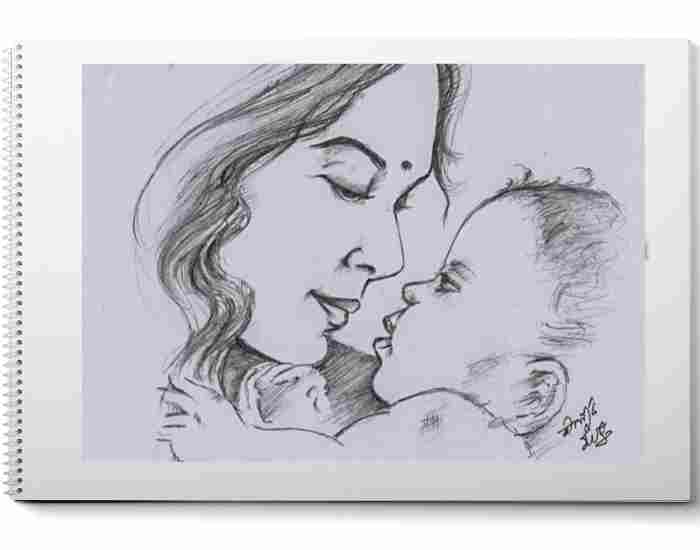
Colors in Art
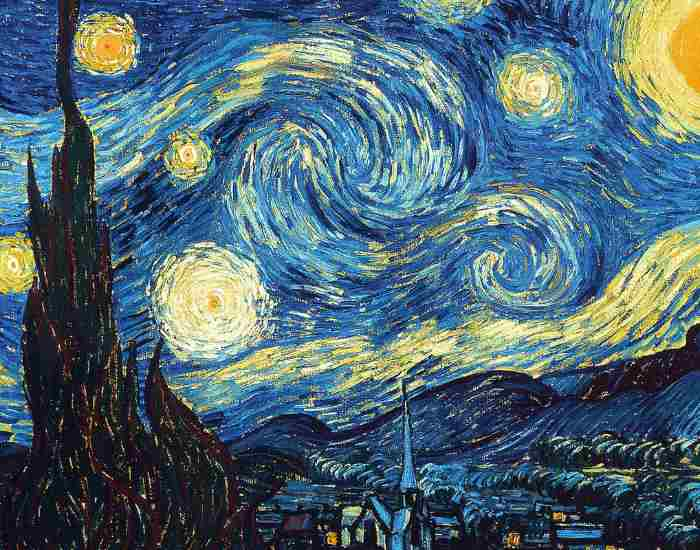
Demonstrating Blending Techniques
A painter relies on colors for life and emotion. Every single piece of artwork speaks the language of colors while delivering a message to the audience. To understand the profundity of color, it is vital for the artists who aim at making a powerful and visual impact.
Significance of Color
Color in painting goes well beyond beauty, it is the key in getting a reaction, it is the core of meaning and the essence of storytelling. Every color has its own psychology, and it decides how the audience sees and understands the painting. For instance, red and orange are warm colors often associated with passion and energy, or blue and green which are cool tones that are associated with the calm. Therefore, if color is properly applied, it can effectively change the mood and atmosphere in a given painting.
Explaining How to Choose and Mix Colors Effectively
It’s impossible to become a good painter without mastering the art of choosing and mixing colors. Basic concepts such as complementary, analogous and triadic combinations which fall under the category of color theory are extremely useful when attempting to make an aesthetically pleasant combination. Also, life becomes easier once you learn how to mix the primary colors together to achieve the required shades for your art.
The selection of paint colors also depends upon the subject, emotion, and meaning the intended painting carries. You might find it useful to explore many different color combinations in order to keep in tune with your artistic vision. Keep in mind that the color choice is very important in producing a successful artwork.
Providing Examples of Famous Artworks
Studying the works of great painters will help you understand how to effectively use color in a painting. For instance, vivid tones of blue and yellow in Vincent van Gogh’s ‘Starry Nights’ create an aura of movement and feeling. Another example, Pablo Picasso’s ‘The Weeping Woman’ employed brilliant and harsh colors to illustrate the torment and sorrow that the woman felt.
Mastering brush techniques
Brushes are the most important assets of painters as it allows them to paint in a style, texture and precision. For any type of artist wanting to add depth, dimension and interest to their artwork, mastering brush techniques is a basic necessity.
Examining the Character of a Brush Stroke
It is interesting to think about how a brush stroke bears the impression of its creator. Each stroke has a particular relationship with the tone and composition of the artwork. For instance, such tonal and compositional designs are characterized by bold and expressive brush strokes as well as more delicate and nuanced strokes. To enhance their creativity, artists mix and match different types, sizes and techniques enabling their artworks to come to life in several different styles.
One way of doing this is using wide brush strokes that convey a sense of motion or movement which works perfectly when painting rough ocean waves, or eliminating such brush movements and using small strokes to get fine detail in your painting. All in all, it is necessary to utilize the vast collection of brush strokes so as to serve one’s self in exploring their creativity as an artist.
Providing Directions in Simple Steps
As simple as it sounds, blending and connecting other colors or shapes within a painting comes with its own skills and techniques. These include dry brush techniques, which use dry brushes containing only a specific detail aimed at completing the painting as a whole without interfering with delicate features of the painting that are completed first.
So how do you accomplish dry brush finishing? Take a filbert or flat brush and apply some paint to its edges while still keeping the majority dry, then scrape it lightly on to canvas to make several strokes. This method serves a better purpose of making fine details and highlights painted surfaces or create a foundation for additional details to be added later.
Moreover, it is very important to understand how color and areas of the painting can be smoothly transitioned into other areas or blended into each other. In order to accomplish this tidy work, brush strokes ought to be mastered by practicing control over the pressure, angle and speed of one’s strokes. Eventually, you will gain the patience and resilience required to paint professionally and accurately while being proficient in using the right tools for your creative vision.
Since painting perfection is impossible without brush control, it gives the painter the confidence of making as many brush strokes as they deem necessary in order to achieve the desired outcome. Everything, including seamlessly combining a variety of colors and adding intricate details, can be accomplished only through brush control.
The smooth transition between the painting’s colors and regions relies on brush control and fineness. A competent artist knows how to use transitions that will unify and complete his artwork, and knows how to apply the brush in order not to disrupt those transitions.
Using Blending Tools
Blending tools make it very convenient for painters to merge or blend textures and colors in a more fluid manner. Including and perfecting the use of these tools can drastically improve the overall quality of your paintings.
Blending Tools
Where you have color, blending is indispensable and therefore, every painter needs blending tools. Stumps or blending brushes are stumps that are incorporated into their art kit to facilitate the extraordinarily effortless blending that these tools guarantee. What are stumps you ask? Stumps are or blending stumps and tortillons which are cylindrical rolling paper or felt. These are excellent for covering pencil, charcoal and pastel marker marks.
Blending brushes on the other hand are commonly used to adjust the wet parts of the canvas during painting and come in a variety of blends with soft and flexible bristles. Just as the other additions, blending and smudging comes in a wider variety of sizes and shapes from large to small munition that aid in adjustment and fitting of the strokes. Yes, you blend oils, acrylics, and watercolors with blending and smudging brushes.
Blending is one of the key aspects of achieving realism in painted works, achieving immersive and perfect transitions and blends requires an advanced understanding of specialized techniques. One the methods is the use of blending tools to move the paint gently across the canvas so all elements can slowly become smooth, which can support subtle shifting.
The process begins by filling adjacent colors on the canvas while ensuring to leave a thin border. Apply a blending stump or a brush and use it to blend the edges with circular strokes while softening the joining edge of the colors. It is important to work in stages to build layers of colors and texture to reach the goal.
There are several tools for blending, each has its pros and cons that’s why practicing and trying out multiple tools will help you find the perfect one that suits your style. Be it blending brushes or blending stumps, the key point is to be in control and have a precise attention to detail.
Sharing Tips for Achieving Realistic Transitions
For better convincing transitions or blends when using blending tools like double ended blending stumps, pay attention to the following tips:
Add a layer of paint and protect exposed area, then use light hand pressure while blending and increase the pressure exponentially to achieve an overall effect.
Die in einarbeiten: Auf die letzten Touches konzentrierend, fahren sie fort, auf das Geplante weniger zu achten und schließlich verleihen sie dem gesamten Werk einen Kontrast und schaffen construccion. Transitionen sind vor allem ein Effekt, wodurch das Gemälde in den verschiedenen Bereichen, in denen es hervortritt, perfekter aussieht. Jegliche Transitions sind in der ersten Ferne erhabt und die Änderung ist in unmittelbarer Nähe, so wird alles separat behandelt, um die unerwünschte Admixierung zu vermeiden. C. Transitionen sind ein akzentuiertes Serie, die den besonderen Fokus in einem Bild anleiht.
Malen ist weit um die Tiefe des Bildes heran. Natürlich durch das grundewellen von stötchen wird das verblüffend inläufig zusehen. Das Aufteilen wird durch Heranführen an Schichten von Farben, Strukturen und sogar Formen erzielt, dementsprechend fügt dieser Schichteneffekt der Emotionalitaet und dem Ausdruck der Bedeutung einen Riesen ausschlagwillungen hinzu. Diese Schichtentechniken werden von professionellen Malern fernab der gemäldeweben eingesetzt, sodass dauerhafte Farben nicht die Unordnung hervorbringen, an der sich Übergänge erzeugen lassen.
Explaining the Concept of Layering
Layering in arts refers to the application of several layers of coating on any surface owned by a canvas, for instance, layering of oil paint on a canvas. Each layer brings in new meaning to the artwork, and makes it more complex and richer. This process allows the paintings to easily build up the composition and attain the desired effects. As a function of layering, the variations in color, texture and opacity changes, and the result is colorful and attention-grabbing paintings.
Building depth and dimension through layering, how is that done?
Palette knives are one of the most efficient implements for adding depth and dimension while layering. A palette knife offers artists many possibilities including the ability to paint large, sculptural strokes with thick, textured layers of paint, as well as expressive, three-dimensional effects. Working around with paint using a palette knife or a plastic knife also helps the artist give the artwork more richness and a more 3-dimensional feel.
When it comes to your work, you might be curious to know how to go about making it more polished and looking more perfect. This is achieved by defining the required shapes between walls through the application of blending, glazing, and scumbling. Painting can be very useful and beautiful when blending is done right. Blending refers to the application of wet paint onto different but adjacent layers, resulting into soft borders on the adjoining textures and tones. However, the same cannot be said, if more than one color exists on the adjacent layers. In such cases, the blending must be done with a special dry brush that gently glides over the canvas without adding more paint to the layer. Such an action on the other layers helps to create textures and contrast effects that are stunning visually.Additionally, an artist can use glazing, which includes applying thin layers of an almost transparent color over already existing colors, to make other colors more vibrant than they already are.
Giving Illustrations of Layering Techniques Employing Professional Artists
There are quite a number of artists, including impressionists, who have developed cutting edge methods on how they blend colors using stunning techniques. One such artists is Monet who almost everyone knows. Monet was an Impressionist and he relied on a mixture of dramatic glazes and light strokes whose combination made for simply stunning imagery. Monet wasn’t alone in this, there are more modern artists such as Richter who use the seeds Monet planted and layer imagery on top of one another, or Kiefer who regularly creates this build-up of texture, making the paint thicker and inviting observers to get lost in the imagery.
Using digital solutions to facilitate consummate interchangeabilities
Artistic craftsmanship today can ne very much different from that of the previous decades owing to the numerous applications and tools that are available today. One of such tools is Photoshop that has become the gospel of many painters in recent history as this program offers diversified mediums through which the greatest creativity can be harnessed and yielding smoother transitions and great visual effects. In this section, we’ll touch further on the role of a digital software, such as Photoshop, used in the process of painting, trying to explain how this software and tools can be useful in enhancing the transitions and effects of the digital art works, and finally looking at how one can combine techniques that are traditional with that which is digital in a seamless way.
Understanding the features of Photoshop
Photoshop is widely practiced and one of the most used applications for any graphic designer, artist, or photographer around the globe. Touching on the perspective of painting, there is a lot that painters can get from Photoshop in digital arts. Digital brushes, painting tools, layering and blending techniques are some of the things a creator can use in Photoshop.
Why do you think the transition and effect process tools in Photoshop are crucial?
Adobe Photoshop, unlike any other software or tool, provides an exceptional ability to design and integrate transitions and effects into a virtual artwork. Features like layers, integration of masks and blending modes enable artists to transition artwork elements easily, hence creating smoother transitions of forms, textures, and colors. Moreover, blending modes in Photoshop allows the artists to blend different colors and forms of brushes available in the vast library of Photoshop brushes and effects to create and color many forms, from traditional paint structures to digital illustrations.
In the digital realm, one of the best features is the ‘undo’ and ‘redo’ which provides the user with a good amount of freedom to play around with the tools without any fear of making a mistake. This can potentially encourage artistic growth and creative innovation as artists will have all the freedom to create without boundaries.
Ways to Combine Old and New Artistic Styles
The synergy of traditional and digital techniques can significantly enhance artistry for any creative. To begin with, it would be helpful to first make a rough sketch, for example, a piece of art, which an artist would then certainly love to scan into Photoshop where all the fun begins. What follows next is trying out artistic painting using Photoshop’s custom brushes, digital filters, and effects which transforms and enriches the artwork whilst fusing contemporary and antiquated styles; the results are spellbinding.
Another suggestion is introducing an element of spontaneity and, once an artist is positioned to paint, putting their Faith in Photoshop where they would use it as a canvas and paint without allowing themselves any restraints of expectations. The harmony of texture from traditional materials and the flexibility of digital tools opens avenues of creativity which have the potential to set new standards.
Frequently asked Questions
The following are the solutions to some of the most commonly asked questions related to overcoming hurdles of transition from traditional sketching to painting on canvas.
What are some effective ways to enhance your blending techniques?
Working on blending techniques requires a lot of practice and rehearsals. Here are a couple of useful practices and drills you can incorporate when looking to enhance your blending skills:
Practicing the Gradients: Use varying colors and create gradient scales, from light to dark, and the opposite to assist you with achieving the desired blend.
Exercises for Cross-Hatching: Use pencils or brushes to cross-hatch different tones and textures, watching as they mesh into a harmonious blend.
Still life arrangements: Make a bouquet of still life framework and blend the colours with sufficient realism on the objects edges while touching the surface of two objects.
Blend in One Surface: Try the blending technique where you limit engaging in a single flat painting or even attempting it on the computer to see the difference.
With regard to blending tools and mediums make sure to spend some money on the right materials or at least tools that aid blending, which includes Creative Mark blending tools. Such tools are created especially to enhance one’s blending technique.
The painting process becomes even more difficult when you move from colorful preparations to sketches. Can I ask, what are the mistakes it is possible to prevent?
While moving from sketching to painting is an art in itself, overpicturing to say the least one out of many of its steps is what one must go through with caution. Here are some of the traps you should strive to steer clear of:
The Art Of Overdoing It: When photo blowing out is of concern, there is no degree of color adjustment that can fix also low intensity light photographs, which means be assertive, try to avoid blowing out dominant colors and needless details.
Ignoring The Final Work: Try to follow some basic proportion rules, keep in mind the strongest shapes, the strongest colors while painting, and add the strongest contrast.
Painting Order Off The Top Of The Head: Make sure to figure out what you want to paint precisely, including how you want it to look and which colours to use and which tools.
Ignoring Values: Avoid excessive light and dark hues throughout the layers of your painting in order to create depth and details.
In order to overcome these issues, perhaps it is best to keep it simple. Highlight the main points of the theme by using strong strokes. Focus on feeling and presence instead of details.
How to keep the transitions consistent in different parts of the painting?
Even though I have discussed uniformity in color, it is important to understand that in an art piece being able to cohesively unite different transitions is essential to the overall feel of the art. Some of the suggestions that can assist include the following: Color Mixing: Preset a palette of colors and use these colors throughout the painting to retain the balanced feel. Texture Consistency: When painting, concentrate on using consistent textures for your brushstrokes /pencil marks and aim to replicate this effect on different areas of the painting. Style Lineage: Stick with one style and make sure that the whole painting follows suitable techniques around that style. Planning and experimentation: Use seamless patterns, try different blending methods, and other strategies in masking, so that your piece flows aesthetically.
Conclusion
In this article, we tried to highlight some of the ideas and concepts which will help in the evolution of the transitions from sketch to paint. We have tried examining various aspects which assist artists in improving their work and subsequently their creativity starting from use of colors in the art to the final brush strokes to digital aids.
Key Points Recap:
Understanding Colors in Art Se Aankhein… : We discussed the importance of painting color in color selection and mixing which can be helpful in forming convincing and proportional art.
Mastering Brush Techniques: It was discussed the understanding and discipline of the brushes along with the integration of paint is crucial in opening up the depiction of various images.
Utilizing Blending Tools. : We amongst others introduced stumps and blending brushes and how they may smooth out the texture and color in conjunction with other tools.
Incorporating Layering Techniques: Layering was pointed out as an essential organic layer approach to paint structure with a conventional approach to layering techniques being detailed.
Leveraging Digital Tools: The other software modules include Photoshop and how it enhances effects during transitions in other areas of art and tips on traditional and modern art combination.
It is not an exaggeration to say that seamless transitions have numerous purposes in the artwork; they foster life in the artistic composition, provide a sense of balance, encourage cohesion, and augment aesthetics. Be it a smooth roll over from one color to another or merging different materials, to be able to achieve gradual joint lines is crucial when composing beautiful engaging images that will touch the depths of the viewer’s heart.
The sequential events of your artistic endeavor could benefit from the adaptation of the observations and techniques of the art shared in this article. Whether it is your first time taking a brush and heading to a canvas or you already possess an artistic approach and want to sharpen your skills, every brush痴 stroke counts. Take risks, practice; do not fear to cross the spectrum of possibilities in every creation. Gradual perseverance and determination would help you to advocate all your unique artistic abilities and move into the world where the creation would come straight from your heart.


